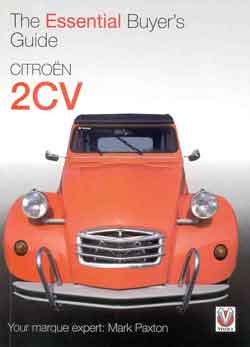The Essential Buyer’s Guide: Citroën 2CV by Mark Paxton Published by Veloce Publishing Ltd. 33 Trinity Street Dorchester, Dorset DT1 1TT, England.
ISBN 978-184584099-0 64 color pages, $19.95 USD.
Click here to order
By Staff
If ever there was a need for one of these “Essential” buyer’s guides, it was for the Citroën 2CV, the beloved “Deux Chevaux” which so typified the postwar French recovery.
Personally speaking, I could get by without such a guide if I were looking for a Fiat, Alfa, or even a Ferrari. But a 2CV? Few in this country have had first hand experience with them, and they are so different most garages won’t let one darken the door. With something like a 2CV, you are on your own, in a simple but strange land of potential problems, pitfalls and mechanical incongruities. But where ever you might live, if you are selling, buying or even thinking of the 2CV, get one of these guides. You’ll never spend so little and get so much.

As we have mentioned, the guides are not only useful, but because of their diminutive size, 7 11/16 by 5 7/16, they can be easily taken along on site while inspecting a car. The covers are glossy paper, but ruled at the binder to facilitate easy opening.
Our lack of familiarity with the car (we’ve road tested then, driven them all over, often wanted one but never actually owned one or worked on one) served to point out a lacking in the Essential Guide series: while photos are ample and in general clear, at least in this particular guide there were no photos of the interiors, or seats; the are no specifications; there are no parts or mechanical drawings included in the book. We must emphasize there that the Essential Guide series is not intended to encompass that kind of material. With the same series of guides on the Italian cars, this was no problem, other books were at hand in our library. But alas, we have nothing on the 2CV yet. On our list would be Veloce Publishing’s book on “How to Restore a 2CV” by Lindsay Porter, which would probably be a great companion book to the Guide.
The “Is it the right car for you?” section is of interest, as the car is so other-worldly that one had better be well informed before falling for this French charmer. And charm they will. But first, don’t be too tall, though interior space for such a small car is actually generous; be ready for rust to be prevalent throughout the car including the chassis; it’s cold in winter because of the air cooled two cylinder engine doesn’t convert heat efficiently and most 2CVs are drafty; anything earlier than a 1970 602CC model will be too slow for a daily driver; and driving it, you will be either loved or hated, depending on your zip code.
On the plus side, the worldwide 2CV organizations have made parts shopping easy. The Citroën is akin to the Ford Model A in that you could create a new 2CV from parts sources if you desired to. Once you get the car figured out, maintenance and repair is relatively simple although a full restoration might require a good (and friendly) shop.
There were about 4 million 2CVs built from 1948 to 1990, in a variety of models, and the differences are critical to the overall value. As we have noted, the pre-1970 cars are not very practical, but the earliest and slowest models built from 1948 to 1960 are the most valuable, and of these the “ripple bonnet” cars the epitome. Oh yes, pre-1970 cars also suffered with 6 volt electrical systems. According to the very knowledgeable authors, the special models built in the post 1970 era won’t add much to the value either, though we are warned to watch out for fakes. Some of the special models are; Charleston, Dolly, 007, (as in James Bond), Basket (as in basket case?) Bamboo, and Spot. We may be wrong, but aside from the Charleston models brought in to the U.S. in some numbers, 2CVs weren’t imported regularly, even though the limited displacement made them exempt from EPA (but not DOT) rules.
That makes them all the more rare and unusual Stateside. The 2CV was made in France, Great Britain, and Portugal at the very least, so there are still plenty left in Europe. For the U.S. buyer, that makes looking for a good example difficult. A 2CV is not the kind of car you would want to buy on eBay, unless the price is right and you are not concerned about the condition. If you want to find a good one, you are going to have to look at the car yourself, or with someone who knows the 2CV.
In any event, the “Essential 2CV Buyer’s Guide” shines when it comes to describing the problems associated with any 2CV. And if you thought that Fiat 600s were rotters, the 2CV seems to take the cake in the rust rallies. Paxton, with camera and screwdriver in hands, covers all the areas in which there may be potential rust problems, and in some cases, the last of the line is the worst for the rust. Plenty of good advise here, which will save a great deal of pocketbook ache if heeded.
The upside to the rust problems is that every panel and even the chassis can be replaced, and the parts prices are more than reasonable (at least in Euros!). A 2CV is a fascinating car with a prominent place in post WWII automotive history and a fine collectable.
I believe that 2CVs were assembled (made?) also in North Africa. May be Tunisia ?